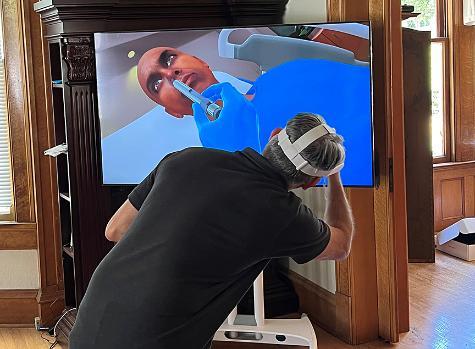Immersive Technology Comes to Touro
Get Real with Touro

Immersive digital environments like those in the films Ready Player One or Free Guy might seem like a far-away future, but the truth is those worlds are already here.
Placing a VR headset on one’s head is all it takes to be dropped a world that looks and feels as genuine and authentic as our own organic reality. The experience can be used for gaming, to whisk people away to exotic travel destinations, or for Touro University California, be used as a training simulation tool for medical scenarios that are difficult or expensive to recreate in real life.
Dr. Jim O’Connor, Director of the Center for Innovative Learning and Teaching, Western Division, is helping develop TUC’s Immersive Technology Learning Center to help train students in critical procedures repeatedly in a controlled and safe manner.
“In 2020, they held Burning Man that year and did the whole thing through immersive technology,” Dr. O’Connor said. From there, he experienced a number of different workshops at Cedars-Sinai Hospital in Los Angeles, one of the global leaders in medical technology of this type.
These experiences helped Dr. O’Connor and his team evolve the concept to the point where students can now be fully immersed in a digital world.
Dr. O’Connor and his team have partnered with Mare Island-based LBX Immersive to bring a suite of training modules so students can practice inserting an IV, a feeding tube and other procedures that have multiple steps that need to be completed in a specific order.
Rather than simply read from a checklist for the purposes of rote memorization, students are immersed in a 3D world where they handle medical equipment and have a conversation with their patient.
LBX’s software package has more than a dozen procedures students can train with already, with new modules added recently that allow the practice of “soft skills” or what some might have at one time called bedside manner.
“In some systems out there, you get a prompt about what to do next, A, B, or C. Well that never happens in the real world,” said LBX Founder and CEO Craig Colwell. “This system uses AI (Artificial Intelligence) so you can have a conversation with the patient.”
The software can also be adjusted to account for people of different socioeconomic backgrounds, those with certain language barriers and other traits to help customize the experience.
The technology won’t duplicate the feeling of actually inserting a needle into someone’s arm, for example, but it will allow students to practice the order of the steps involved repeatedly.
“This is meant to augment the skill development,” said LBX CFO Cary Immesoete. “This is meant to familiarize students with the order of the steps in each process.” The software even includes an evaluation mode, where students are sent back to the beginning if they miss any steps or do them in the wrong order.
Alok Modi, a College of Pharmacy student working with O’Connor’s group, is excited about what the technology has to offer students.
“Being a member of immersive technology taskforce is once in a lifetime opportunity to do innovative things with different technologies on a daily basis,” Modi said. He pointed out that similar technology is being employed to treat people with PTSD, for example, or to help with pain reduction.
“Some physicians and surgeons are using Meta-quest headsets to distract pediatrics by putting on games and movies so kids feel less pain and suffering during surgeries and minor procedures,” he said.
Dr. Natalie Nevins, an instructor with the College of Osteopathic Medicine and an officer in the US Army, is excited about the potential the technology promises. She’s a researcher with VR/AR technology and has helped the military’s development of hyper-realistic™ trauma training.
Severe combat injuries are often very unique and not something physicians experience on a daily basis. Advanced VR technology allows doctors to train with these types of injuries without the need for injured service men and women.
But the technology offers more than training that’s difficult to replicate in the real world.
“You’re really only limited by your imagination,” Dr. Nevins said.
Software already exists that allows an MRI to be overlaid onto the patient it is from or manipulated in 3-D during a procedure.
“Imagine being able to see exactly what it is you’re touching under someone’s skin or have a 3-D MRI image of the anatomy prior and during surgery,” Dr. Nevins said.
Anatomy is already a major focus for existing software platforms and the upgrade to this next level will help medical students fine tune their anatomy skills.
“Everybody’s anatomy is a little bit different,” she said. “The benefit of this technology isn’t in being able to dissect something over and over again as much as it’s about being able to quickly locate exactly what you’re looking for.”
The next evolution, which has wide-ranging applications at Touro, will be the ability to have a “multiplayer game” of sorts. The day is not too far off, Dr. Nevins said, when teams of PA students, Nursing students, and medical students will be in a hyper-realistic™ virtual world, working on the same patient all at once as they would in a hospital or other clinical setting.
“Leveraging new technology gives us another platform to engage with students who have all grown up playing video games,” Dr. Nevins said.
